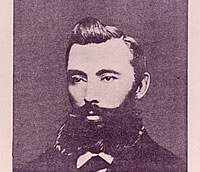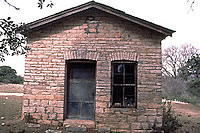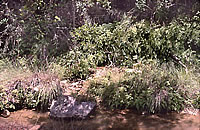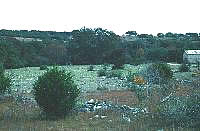
Former Travis County district clerk Ernst
Hallman moved to his hill country lands in 1882 to raise sheep.
Photo circa 1875, courtesy Travis County Bar Association and
Senator Ralph Yarborough.
Click images to enlarge
|

Section of Map of Texas circa 1888, showing
location of Colberg, where Hallman served as postmaster for
two years. Colberg was also the name of his birthplace in
Prussia. Map courtesy of Center for American History, Swante
Palm Collection.
|

The southeast side of the building was
the more ornamented, with lintels over the door and window.
During the 1880s, this side was likely the front door. Although
the road has now been moved, an aerial map from the 1930s
shows the faint traces of an old road winding past this side
of the building and on throughout the Barton Creek community.
Photo by Tom Hester.
|
|
In 1882, prominent Austin businessman Ernst Hallman
determined to make a dramatic change in his life. Ten years previously,
the native of Colberg, Prussia, had been terribly injured in a train
accident in Manor, Texas. As a result, both his left leg and right
foot had to be amputated. Although he continued working as a district
clerk for Travis County for several years afterward, he apparently
was ready to leave city life behind. Having purchased more than
2400 acres of raw land west of the city, Hallman and his wife, Johanna
Schenck Hallman moved to the Hill Country to raise sheep.
Little is known of the outcome of his venture. For
even the toughest and most able bodied of men, the tasks of establishing
a ranching operation must have been daunting. Even today, the rocky
roads traversing the property Hallman once owned are rough and,
during bad weather, treacherous. And yet postal records tell us
that from 1883 to 1885, he also served as the postmaster of the
community of Colberg in the "Hays/Travis area." Did the
native of Colberg, Prussia, give this small enclave the name of
his birthplace?
Today, all that is left on the land he once owned
is a well-constructed stone building on a high ridge overlooking
a tree-lined hollow. The 16-x-35-foot building is coursed masonry:
hand-cut limestone laid with a mortar of burned lime and sand. The
interior is dirt-floored and one-room wide, although a frame partition
divides the interior into two sections.
In the fields surrounding the building, patterns of
rock are aligned in large rectangular patterns, perhaps the remnants
of corrals or pens. Piles of cut wood, nails, and other building
materials indicate that other structures, some say bunkhouses, once
stood in the area as well.
Based on the artifacts, the stone structure
and outbuildings were used chiefly as a residence and for
farm or ranch purposes. As a group, the artifacts date the
site from the 1870s to the early 1900s: fragments of heavy
white tableware popular in the 1880s and 1890s, sherds of
stoneware crocks and churns; bits of bitters, Schnapps and
beer bottles from the 1870s to early twentieth century. Parts
of a cast iron stove, horseshoes, a metal pail, baling wire,
and other objects were found in the adjacent fields.
Yet, ranchers in the area today clearly recall
their grandparents' stories describing the stone building
not only as a store but also as containing wooden post office
boxes, a combination of services typical in rural communities.
Small country stores chiefly carried basic items required
for everyday life such as flour, sugar, coffee, and salt as
well as a limited supply of dry goods and such non-staple
items as snuff, bitters, medicine, liquor, and candy. The
storeowner and his family often lived in one end of the store
partitioned off from the commercial side. Because the objects
sold in the store were intended largely for household use,
they would be largely indistinguishable from artifacts found
in a rural dwelling. For archeologists sorting through these
remains, the problem of the building's function was frustrating,
and is, as yet, not fully resolved.
Whatever his role—rancher, storekeeper,
postal clerk, or all three—Hallman remained at the scenic
hilltop compound for only a decade, moving back to Austin
with his family shortly before his death in 1892. His widow
and two daughters retained ownership of the property until
1907. Today, the small hollow at the base of the hill still
carries his name, although the spelling has changed over time.
|
|
For even the toughest and most able bodied of men, the
tasks of establishing a ranching operation must have been
daunting.
|

Strong springs sustain fern-lined pools
and a small stream in the tree-lined hollow below the stone
building. In the creek, investigators found cut limestone
blocks which are thought to be the remains of a springhouse,
where foods and dairy products could be kept cool. Photo
by Susan Dial.
|

Fields adjacent to the stone building contained
alignments of stone and small piles of building debris. Photo
by Susan Dial.
|

Rectangular patterning in the lines of
stone suggest they are the remnants of stone walls, perhaps
corrals or pens for sheep or other animals. Photo by Susan
Dial
|
|